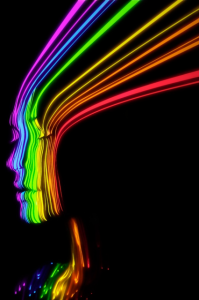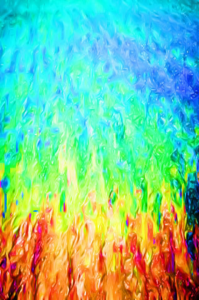Inspiring Interior Design (Part 17)
By Asher Crispe: August 28, 2012: Category Inspirations, Quilt of Translations
The Emotive Spectrum
 Everything is built on relationships. We have already explored how the six ‘model’ rooms of the house correlate with the chambers of the heart, while the heart or body itself equates with the house overall. Abstractly we have a situation where six elements are contained within a seventh (whereby that seventh is really nothing more than the combination of the other six). In Jewish observance and tradition many may recognize this as the form of the Sefer plate from the Passover Holiday. There too six items are placed inside the plate which provides six place holders. This same arrangement applies to the emotive registry of color as well.
Everything is built on relationships. We have already explored how the six ‘model’ rooms of the house correlate with the chambers of the heart, while the heart or body itself equates with the house overall. Abstractly we have a situation where six elements are contained within a seventh (whereby that seventh is really nothing more than the combination of the other six). In Jewish observance and tradition many may recognize this as the form of the Sefer plate from the Passover Holiday. There too six items are placed inside the plate which provides six place holders. This same arrangement applies to the emotive registry of color as well.
Six colors (which further subdivide into two groups of three, just like our rooms are divided into the living, kitchen and dining ‘public-day’ primary rooms and the boy’s, girl’s and master bedrooms as secondary ‘private-night’ rooms) are composed of three primary colors and three secondary colors. The medieval kabbalist Rabbi Avraham Abulafia (1240-1291?) extracts this configuration from the fact that the first word of the Torah, Bereshit or ‘In the beginning’ (בראשית), has as one of its ‘secret’ permutations the words bara shait meaning ‘created six’ (ברא שית).
Here ‘created six’ refers to a set of archetypes whose imprint established the six week days in the account of Creation. Every day is another color, another emotive sphere, another spatial direction (as there are six extremities to space: up/down, right/left, front/back). The secret of the seventh day as the Sabbath (Shabbat) acts as the housing for the other six, the container for the set, the culmination of a process. In Hebrew, the word for the Sabbath (Shabbat) is sometimes described as a poetic contraction of the phrase shalom bayit meaning the ‘peace of the house or idiomatically ‘domestic tranquillity.’ From this we can assert that chromatic harmonies in our homes dovetails efforts to arrive at emotional compatibility–where all our feelings can reside together without inner conflict.
Abulafia further contends that the primordial six really stem from just combinations of three. His supports this with a gematria in that Bereshit (In the Beginning) = 913 which also equals the expression shelosha devarim yachad or ‘there things together’ (שלשה דברים יחד). In other words, different combination of these three things will generate the full array of six. In a certain sense this is lesson one for color theory. Six colors in all can be reduced to just three primary colors of blue, red and yellow. These primary colors, when mixed together, produce the three secondary colors of violet, orange and green. Violet is derivative of the mating of blue and red, orange from red and yellow and green from blue and yellow.
This exact same breakdown occurs in the emotive powers of the soul. Six in all, they are clustered into two groupings: the primary emotions which correspond to the primary colors and the secondary emotions which relate to the secondary colors. Primary emotions are called ‘aroused emotion’ or murgash from the word regish meaning ‘felt sensation.’ These emotions represent our baseline emotive life. Other emotive experience really amounts to compounds of these building block feelings (lovingkindness, strength [severity/judgement], and beauty [compassion]). Secondary emotions are behavioral (not directly dependent of a stimulus) and are classified as mutba from the word tevah meaning ‘nature.’ As reactions to an experiential feed, the primary emotions sparked by an interaction remain closer to the experience that engendered them, while the secondary emotions are natural side effects of the primary emotions but reside in a more aloof place within consciousness.
Here is a basic itemization of the triplets:
The primary emotions and colors
Blue (kachol) is understood to be an admixture of blue inclined towards white, or what is more commonly thought of a silver. Silver also has an alternate name in Hebrew which is kesef. Many rabbinic commentators have noted that this same root can also signify a ‘yearning desire’ or longing (kasaf). Therefore, blue, or more precisely silver, presents a force of attraction. Emotively this is lovingkindness (love attracts and kindness is desirable while severity repulses).
Red (adom) contains the word dam (meaning ‘blood’) within it. The shedding of blood through the might (gevurah) of the sword issues from the attribute of severity. We should recoil at the sight of blood. A bloodshot face is full of anger. To mortify someone (from mort meaning ‘death’ in French) amounts to reddening their face with embarrassment. This is why the sages of the Talmud liken the public embarrassment of someone to murder. It is ‘character assassination’ or ‘mortification.’
Red is also a power color which further connects it to gevurah (the second primary emotion) which means ‘strength’ or ‘might.’ If you want someone to stop and look at you then wear red. As Jean Baudrillard observes (The System of Objects p. 31): “ ‘Loud’ colours are meant to strike the eye. If you wear a red suit, you are more than naked–you become a pure object with no inner reality.” ‘Striking the eye’ is clearly an experience of strong intensity and severity (gevurah). On a side note, Jewish laws of modesty (tzniut) have generally frowned on the color red for just this reason. Red does not just attract attention (immodest); it assails the onlooker. Just consider the statement that a ‘hot’ red sports car makes.
 Yellow (tzahov) is the color of the sun. Throughout kabbalistic literature the sun is depicted as the attribute of tiferet or beauty. Besides the obvious association of sunshine and the color yellow, the word tzahov also carries the connotation of ‘brightening.’ The beautification of our world, the brightening up of our day, the warming of our lives, is by virtue of the compassion (the inner aspect of tiferet or beauty). In Psalms 84:12 “For the sun and [its] shield are Havayah [God above nature] [and] Elokim [God within nature].” The transcendent aspect of Divinity sweetens the judgement of the immanent aspect of Divinity within nature (Elokim) by tempering severity with compassion and mercy. Thus, since this attribute or name of the Divine is likened to the sun (which transcends our direct line of sight for it overwhelms and blinds us) and the sun is yellow, it follows that yellow occupies the position of beauty whose inner experience is one of rachamim (compassion and mercy).
Yellow (tzahov) is the color of the sun. Throughout kabbalistic literature the sun is depicted as the attribute of tiferet or beauty. Besides the obvious association of sunshine and the color yellow, the word tzahov also carries the connotation of ‘brightening.’ The beautification of our world, the brightening up of our day, the warming of our lives, is by virtue of the compassion (the inner aspect of tiferet or beauty). In Psalms 84:12 “For the sun and [its] shield are Havayah [God above nature] [and] Elokim [God within nature].” The transcendent aspect of Divinity sweetens the judgement of the immanent aspect of Divinity within nature (Elokim) by tempering severity with compassion and mercy. Thus, since this attribute or name of the Divine is likened to the sun (which transcends our direct line of sight for it overwhelms and blinds us) and the sun is yellow, it follows that yellow occupies the position of beauty whose inner experience is one of rachamim (compassion and mercy).
To be continued in Part Eighteen where we will work our way though the secondary emotions and more…
http://www.interinclusion.org/inspirations/inspiring-interior-design-part-18/























;)
;)
;)
;)
;)
;)
;)
;)
;)
;)
